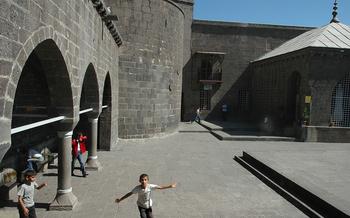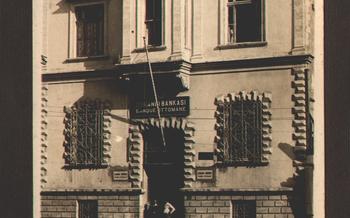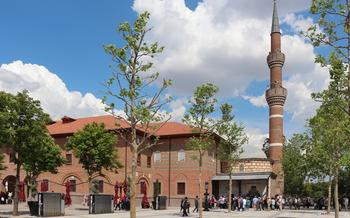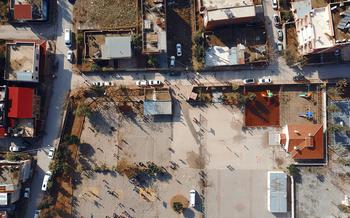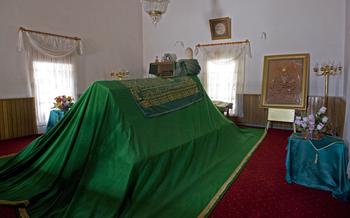
Seyh Saban i Veli Kulliye and Shrine
- Location and Accessibility: Finding the Sacred Site
- Dress Code and Etiquette: Respecting Local Customs
- Historical Background: Unveiling the Story of Seyh Saban i Veli
- Architectural Marvels: Exploring the Complex's Design
- Sacred Spaces: Experiencing the Shrine's Serenity
- Calligraphy and Ornamentation: Admiring the Artistic Details
- Ceremonies and Rituals: Witnessing the Living Traditions
- Local Customs and Traditions: Embracing the Culture
- Historical Significance: Understanding the Kulliye's Role
- Educational Programs: Enriching the Visitor Experience
- Photography and Videography: Capturing the Beauty
- Souvenirs and Mementos: Preserving the Memory
- Insider Tip: Unveiling the Hidden Gem
Location and Accessibility: Finding the Sacred Site
The Seyh Saban i Veli Kulliye and Shrine are situated in the heart of Kastamonu, a city steeped in history and natural beauty. To reach this sacred site, visitors can embark on a scenic journey from major cities like Ankara or Istanbul. From Ankara, the drive takes approximately 6 hours, while from Istanbul, it's a 7-hour adventure.
Once in Kastamonu, the Kulliye can be easily found in the city center, near the banks of the Gökırmak River. Its prominent location makes it a landmark that is difficult to miss. For those arriving by public transportation, there are regular bus services from various cities, and the bus station is just a short walk from the Kulliye.
For those who prefer a more immersive experience, joining a guided tour is an excellent option. These tours often provide insightful commentary on the history, architecture, and cultural significance of the Kulliye, enhancing the overall visit. Alternatively, visitors can choose to explore the site at their own pace, allowing for a more personal and contemplative experience.
When planning your visit, consider the distance to other popular landmarks and attractions in the area. The Kastamonu Castle, with its impressive fortifications, is just a short walk away. Additionally, the scenic Ilgar Mountain National Park, known for its breathtaking landscapes and hiking trails, is a must-visit for nature enthusiasts, located just a short drive from the city center.
Dress Code and Etiquette: Respecting Local Customs
When visiting the Seyh Saban i Veli Kulliye and Shrine, it is essential to be mindful of local customs and dress appropriately. The Shrine is a sacred place for Muslims, and visitors should show respect for the religious significance of the site.
Conservative attire is recommended for both men and women. Men should wear long pants and a shirt with sleeves. Women should cover their hair, arms, and legs. It is also advisable to remove your shoes before entering the Shrine.
When interacting with local people, it is important to be polite and respectful. Avoid loud noises and refrain from pointing your feet or shoes towards anyone. It is also considered polite to greet people with a handshake or a nod.
By observing these simple guidelines, you can help ensure that your visit to the Shrine is a positive and meaningful experience for yourself and others.
Historical Background: Unveiling the Story of Seyh Saban i Veli
Seyh Saban i Veli, a revered Sufi saint, lived in the 13th century and played a pivotal role in spreading Islamic spirituality and Sufism in the region. Born in the village of Ihsaniye in Kastamonu, he dedicated his life to teaching and guiding others on the path of spiritual enlightenment. His teachings emphasized love, compassion, and the pursuit of inner peace through self-awareness and connection with the divine.
The establishment of the Seyh Saban i Veli Kulliye marked a significant chapter in the history of Sufism. The Kulliye served as a center of Islamic learning and spirituality, attracting students and followers from far and wide. Seyh Saban i Veli's teachings and guidance resonated with people from all walks of life, fostering a sense of community and brotherhood.
Over the centuries, the Kulliye has undergone renovations and expansions, reflecting the growing influence and significance of Seyh Saban i Veli's legacy. It stands as a testament to his tireless efforts in promoting Islamic values and contributing to the rich cultural heritage of Turkey.
Architectural Marvels: Exploring the Complex's Design
The Seyh Saban i Veli Kulliye and Shrine stand as a testament to the architectural brilliance of the Islamic world. The complex showcases a unique blend of Seljuk and Ottoman architectural styles, creating a harmonious and visually captivating masterpiece.
At the heart of the Kulliye lies the mosque, a stunning structure adorned with intricate carvings and delicate tilework. Its spacious interior, featuring a series of elegant arches and columns, provides a sense of grandeur and serenity. The mihrab, the niche indicating the direction of prayer, is a masterpiece in itself, adorned with intricate calligraphy and colorful tiles.
Adjacent to the mosque is the türbe, the mausoleum where Seyh Saban i Veli is laid to rest. This sacred space exudes an aura of tranquility and reverence. The türbe's octagonal shape and ornate dome are adorned with exquisite tilework and calligraphy, creating a mesmerizing visual display.
In addition to the mosque and türbe, the Kulliye also encompasses a madrasa, a school of Islamic learning, and a hamam, a bathhouse. These structures, though less ornate than the main buildings, showcase the practical and functional aspects of the complex, serving the educational and hygienic needs of the community.
The Seyh Saban i Veli Kulliye and Shrine are not merely architectural wonders; they are living testaments to the rich history and vibrant culture of Turkey. Exploring this architectural marvel is a journey through time, allowing visitors to appreciate the craftsmanship, artistry, and spiritual significance that have shaped this sacred site.
Sacred Spaces: Experiencing the Shrine's Serenity
The Shrine, the heart of the Seyh Saban i Veli Kulliye, exudes an atmosphere of profound serenity and spirituality. Step inside, and you'll be enveloped by a sense of tranquility that invites contemplation and reflection. The interior is adorned with intricate calligraphy, colorful tiles, and intricate carvings, creating a visually stunning environment that complements the spiritual essence of the space.
The focal point of the Shrine is the mihrab, a beautifully crafted niche that indicates the direction of prayer. Its intricate design and delicate ornamentation draw the eye, inviting visitors to focus their attention towards Mecca. The minbar, or pulpit, stands as a symbol of guidance and knowledge, where religious teachings and sermons are delivered.
As you explore the Shrine, take time to appreciate the exquisite details that adorn every corner. From the intricate patterns on the carpets to the delicate stained-glass windows, each element contributes to the overall ambiance of serenity and spirituality. Whether you're a devout Muslim seeking a place of worship or a curious traveler seeking a glimpse into Islamic culture, the Shrine offers a transformative experience that will leave a lasting impression.
Calligraphy and Ornamentation: Admiring the Artistic Details
The Seyh Saban i Veli Kulliye and Shrine is a testament to the exquisite craftsmanship and artistic heritage of the Islamic world. Calligraphy, a revered art form in Islamic culture, adorns the walls and ceilings of the complex, showcasing intricate verses from the Quran and poetic inscriptions praising the Prophet Muhammad and Seyh Saban i Veli. The calligraphy is executed in various styles, including elegant Kufic, flowing Naskh, and ornate Thuluth scripts, each adding to the visual splendor of the Kulliye.
Complementing the calligraphy is the intricate ornamentation that embellishes every corner of the complex. Geometric patterns, floral motifs, and arabesques dance across the walls, mihrab, and minbar, creating a mesmerizing visual symphony. The use of vibrant colors, such as turquoise, gold, and deep reds, further enhances the beauty of these decorative elements. The symbolism behind the calligraphy and ornamentation is profound, conveying messages of faith, spirituality, and the interconnectedness of all creation.
As you wander through the Kulliye, take time to appreciate the artistry and craftsmanship that went into every detail. Each stroke of the calligrapher's pen, each intricate pattern, tells a story and evokes a sense of wonder and awe. Let the beauty of the calligraphy and ornamentation transport you to a realm of spiritual and aesthetic contemplation, leaving an enduring impression long after your visit.
Ceremonies and Rituals: Witnessing the Living Traditions
The Seyh Saban i Veli Kulliye and Shrine is not just a historical and architectural marvel; it is also a vibrant center of Islamic spirituality and Sufi traditions. Throughout the year, the complex hosts various ceremonies and rituals that showcase the living traditions of Sufism.
One of the most significant ceremonies is the annual Urs, or the commemoration of Seyh Saban i Veli's death anniversary. During this sacred event, thousands of pilgrims gather at the Shrine to pay their respects and seek blessings. The Urs is marked by special prayers, recitations, and devotional music, creating a deeply spiritual and moving atmosphere.
Another important ritual is the zikr, or the remembrance of God. Zikr gatherings are held regularly at the Shrine, where devotees come together to chant sacred phrases, often accompanied by rhythmic music and dance. These sessions are believed to purify the heart and bring one closer to the divine.
Visitors to the Kulliye and Shrine have the opportunity to witness these ceremonies and rituals, gaining a deeper understanding of Sufi practices and traditions. However, it is important to be respectful and mindful of the religious significance of these events. Observing from a distance and avoiding disruption is essential to maintaining the sacred atmosphere.
If you are fortunate enough to attend a ceremony or ritual at the Seyh Saban i Veli Kulliye and Shrine, it is an experience that will leave a lasting impression and provide a glimpse into the heart of Islamic spirituality.
Local Customs and Traditions: Embracing the Culture
The Seyh Saban i Veli Kulliye and Shrine hold a special place in the hearts of local people, who have preserved and celebrated their unique customs and traditions for centuries. Visitors are warmly welcomed and encouraged to embrace the local culture, which is deeply rooted in Islamic values and Sufi spirituality.
When visiting the Kulliye and the Shrine, observe local customs and etiquette, such as greeting people with a friendly "Selamün Aleyküm" (Peace be upon you). Dress modestly and respectfully, covering shoulders and knees. Maintaining a calm and respectful demeanor is essential, especially within the Shrine.
Locals often engage in traditional ceremonies and rituals at the Shrine, such as dhikr (remembrance of God) and sama (spiritual music). These practices are held with devotion and reverence, providing visitors with a glimpse into the depth and richness of Sufi spirituality.
To fully immerse yourself in the local culture, consider interacting with the community members. Engage in friendly conversations, learn about their customs, and share your own experiences. You may be invited to attend local gatherings, such as communal meals or religious celebrations, which offer an authentic and enriching cultural experience.
By respecting local customs and traditions, visitors can show their appreciation for the warm hospitality and rich cultural heritage of the region. Embracing the local culture not only enhances the visit but also fosters understanding, connection, and mutual respect.
Historical Significance: Understanding the Kulliye's Role
The Seyh Saban i Veli Kulliye holds immense historical significance as a prominent center of Islamic learning and spirituality. It served as a hub for scholars, students, and Sufis seeking knowledge and guidance in various Islamic disciplines, including theology, jurisprudence, and mysticism. Over the centuries, the Kulliye played a crucial role in shaping the intellectual and spiritual landscape of the region.
The teachings and guidance imparted within the Kulliye's walls had a profound impact on the lives of countless individuals, fostering a deep understanding of Islamic principles and promoting spiritual growth. The Kulliye's contributions to the development of Islamic thought and Sufism are widely recognized and respected, leaving a lasting legacy that continues to inspire and guide Muslims to this day.
Anecdotes and stories abound, highlighting the Kulliye's pivotal role in Islamic history. One such tale speaks of a renowned scholar who traveled far and wide in search of knowledge. Upon arriving at the Kulliye, he encountered a group of Sufi masters engaged in deep spiritual discussions. Intrigued and inspired, he decided to stay and study under their guidance. Years later, he emerged as a respected scholar and Sufi master himself, spreading the teachings he had acquired within the Kulliye's walls to distant lands.
The Seyh Saban i Veli Kulliye stands as a testament to the rich history and enduring legacy of Islamic scholarship and spirituality. Its contributions have left an indelible mark on the cultural and intellectual heritage of the region, ensuring its place as a revered and cherished site for generations to come.
Educational Programs: Enriching the Visitor Experience
The Seyh Saban i Veli Kulliye and Shrine offer a range of educational programs and workshops that allow visitors to delve deeper into Islamic history, culture, and spirituality. These programs are designed to enhance the visitor experience, providing a comprehensive understanding of the complex's significance and its role in Turkish history and Sufism.
Visitors can participate in guided tours led by knowledgeable experts who share insights into the Kulliye's architectural features, its historical significance, and the life of Seyh Saban i Veli. These tours offer a unique opportunity to learn about the complex's role as a center of Islamic learning and spirituality.
Additionally, workshops and seminars are organized regularly, covering topics such as Islamic calligraphy, Sufi philosophy, and traditional Islamic arts. These workshops provide hands-on experiences, allowing participants to engage with the Kulliye's rich cultural heritage in a meaningful way.
By participating in these educational programs, visitors gain a deeper appreciation for the Seyh Saban i Veli Kulliye and Shrine. They leave with a greater understanding of Islamic history, culture, and Sufism, creating a lasting and enriching memory of their visit.
Photography and Videography: Capturing the Beauty
The Seyh Saban i Veli Kulliye and Shrine offer a visually stunning backdrop for photography and videography enthusiasts. However, it is important to be respectful and mindful when capturing the beauty of this sacred site.
When taking photos or videos, please be mindful of the privacy of other visitors and avoid disturbing them. Always ask for permission before photographing or filming people, especially if they are engaged in prayer or contemplation.
Use a tripod to stabilize your camera and avoid blurry images. This is especially important when taking photos in low-light conditions, such as inside the Shrine.
To capture the essence of the Kulliye and the Shrine, try to focus on the architectural details, the intricate calligraphy, and the serene atmosphere. Experiment with different angles and perspectives to create unique and captivating shots.
Remember, the Seyh Saban i Veli Kulliye and Shrine are sacred places, so it is important to be respectful and maintain a quiet and contemplative demeanor. By following these guidelines, you can capture the beauty of this historic site while preserving its sanctity.
Souvenirs and Mementos: Preserving the Memory
As you depart from the Seyh Saban i Veli Kulliye, consider taking a piece of its spirit with you through souvenirs and mementos. Within the vicinity of the complex, you'll find shops and vendors offering a variety of items imbued with cultural significance and craftsmanship.
For those seeking tangible reminders of their visit, intricately designed prayer rugs, adorned with verses from the Quran and motifs inspired by Islamic art, make for cherished souvenirs. Alternatively, decorative tiles, featuring calligraphy or geometric patterns, can serve as vibrant additions to your home décor, evoking the beauty of the Kulliye's architecture.
If you're drawn to the spiritual essence of the site, consider seeking out traditional Islamic calligraphy, meticulously rendered by skilled artisans. These pieces, adorned with verses from the Quran or the sayings of the Prophet Muhammad, carry deep religious significance and can create a serene atmosphere in any space.
Beyond tangible mementos, the Kulliye's surroundings offer a rich tapestry of local traditions and crafts. Take the opportunity to explore the vibrant bazaars and shops, where you can find handmade textiles, pottery, and jewelry, each reflecting the region's unique cultural heritage.
Remember, by supporting local artisans and purchasing authentic souvenirs, you not only preserve cultural traditions but also contribute to the livelihoods of the community. As you return home, these mementos will serve as tangible reminders of your journey and the enduring legacy of Seyh Saban i Veli.
Insider Tip: Unveiling the Hidden Gem
Beyond the main attractions of the Seyh Saban i Veli Kulliye and Shrine, there lies a hidden gem waiting to be discovered. Tucked away in a secluded corner of the complex, visitors can find a serene and tranquil garden, a sanctuary of peace and tranquility amidst the bustling activity of the site. This enchanting garden, adorned with colorful flowers, fragrant plants, and murmuring water features, offers a respite from the crowds and invites visitors to immerse themselves in a moment of contemplation and reflection.
As you stroll through the garden's winding paths, you'll encounter hidden nooks and intimate seating areas, perfect for taking a break and soaking in the serene atmosphere. The gentle sound of water flowing from a nearby fountain creates a soothing ambiance, while the sweet scent of jasmine and roses fills the air. This hidden oasis is the ideal place to escape the hustle and bustle of the Kulliye and connect with your inner self.
Whether you choose to sit in quiet contemplation, read a book, or simply bask in the tranquility of the surroundings, the hidden garden offers a unique and unforgettable experience. It's a place where visitors can find solace, recharge their spirits, and create lasting memories of their visit to the Seyh Saban i Veli Kulliye and Shrine.



